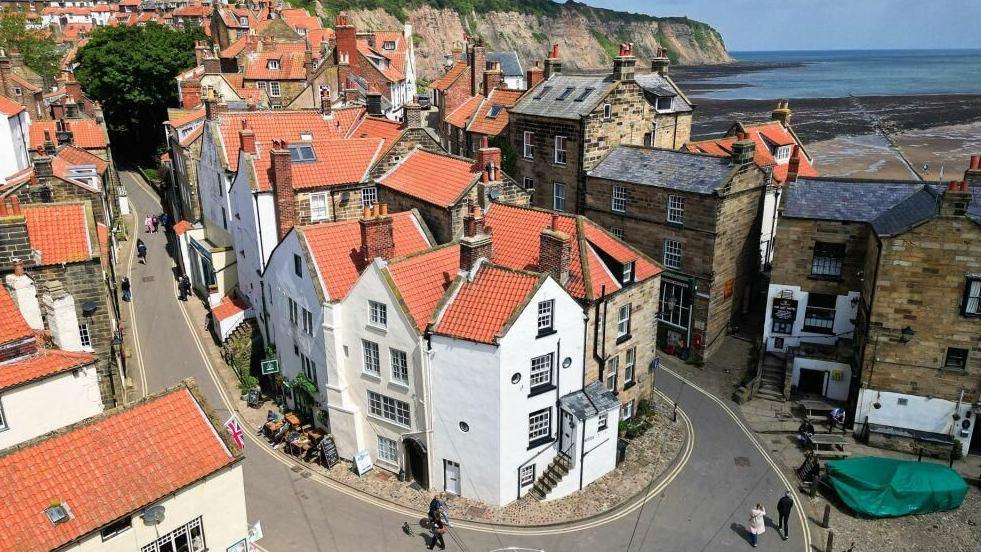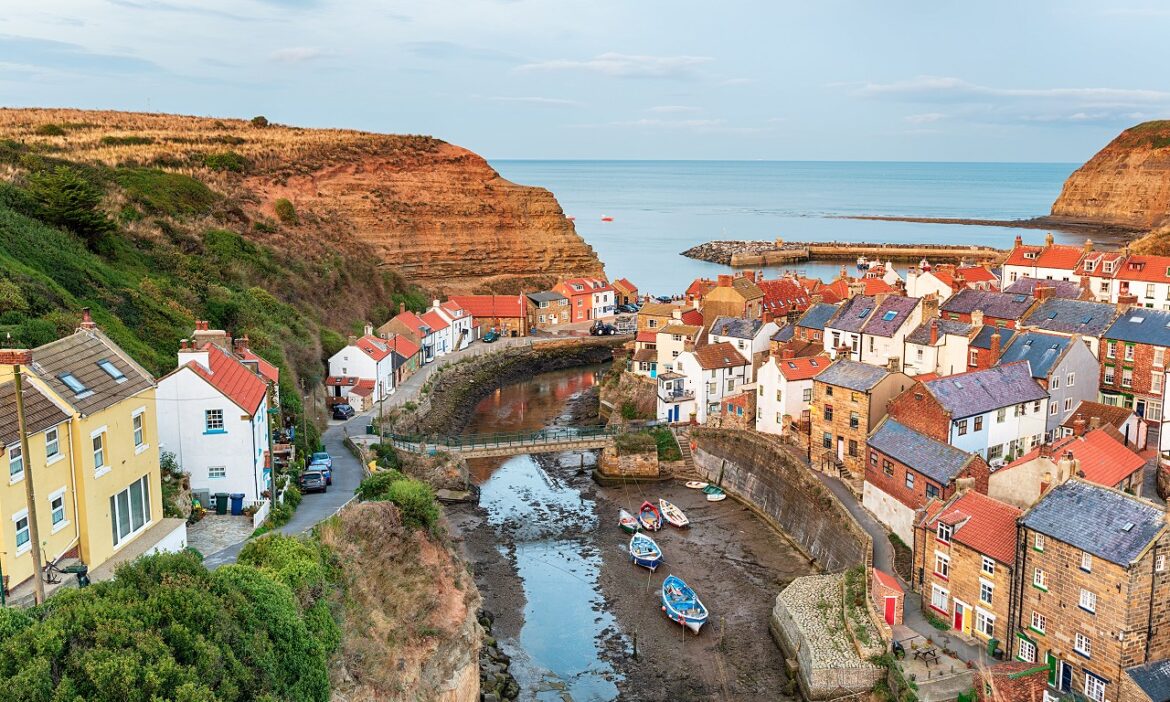Perched dramatically between the cliffs of the North York Moors National Park, Robin Hood’s Bay is one of the most enchanting and picturesque villages in England. With its maze of steep, winding cobbled streets, red-roofed cottages clinging to the hillside, and sweeping views of the rugged coastline, the bay captures everything that makes the Yorkshire coast so special — beauty, history, mystery, and charm.
Despite its small size, Robin Hood’s Bay holds an outsized place in the hearts of those who visit. It is a place where legends linger in the sea breeze, where tales of smugglers and sailors are woven into the fabric of the village, and where time seems to slow as you wander through its labyrinthine lanes. Whether you’re drawn by its history, its coastal walks, its wildlife, or simply its irresistible atmosphere, Robin Hood’s Bay is a destination that never fails to captivate.

A Village Steeped in Legend
The first thing many visitors wonder about Robin Hood’s Bay is, of course, its name. Despite the obvious association, Robin Hood himself never actually lived here — at least, not according to any historical record. The origin of the name remains something of a mystery. Local folklore tells of the famous outlaw coming to the bay to outwit French pirates, returning the stolen loot to the local villagers. While there’s no evidence to support this tale, it fits perfectly with the spirit of adventure and rebellion that defines the place.
The earliest recorded mention of Robin Hood’s Bay dates back to the 12th century, when the area formed part of the Whitby Abbey estate. Back then, it was a quiet fishing settlement, its inhabitants making a modest living from the rich bounty of the North Sea. Over the centuries, the village grew organically, the houses tumbling down the cliff in an almost haphazard fashion, giving it the unique character we see today.
A Haven for Smugglers
During the 18th and early 19th centuries, Robin Hood’s Bay became infamous for smuggling — and with good reason. The coastline between Whitby and Scarborough was one of the busiest smuggling routes in England, and the village’s geography made it ideal for such illicit trade. Its tight network of alleyways, tunnels, and interconnected cellars provided the perfect cover for hiding contraband such as tea, gin, tobacco, and silk.
It’s said that a barrel of rum could be passed from the shore to the top of the village without ever seeing daylight, moving through a secret web of passageways that linked house to house. Entire families — even the local vicar, according to some stories — were involved in the trade, ensuring that smugglers could evade the excise men who patrolled the coast.
Today, visitors can still sense the echoes of that clandestine past as they explore the twisting streets. The names of cottages and inns, such as “The Smugglers” or “The Bay Hotel,” are reminders of those daring days when the village thrived on its shadowy economy.
The Fishing Village That Time Forgot
Even as smuggling faded, fishing remained central to life in Robin Hood’s Bay. Generations of fishermen set out from its small beach to harvest cod, herring, and crab from the cold North Sea waters. For centuries, the rhythm of life here was governed by the tides and the weather, and that heritage is still palpable today.
Though the fishing fleet has dwindled, the bay retains its maritime soul. Old nets, lobster pots, and boat sheds dot the shore, while the village’s small museum — the Robin Hood’s Bay Museum, housed in the old coastguard station — tells the story of the local community, its shipwrecks, lifeboats, and sea rescues.
Wandering the streets, you can still find houses that once belonged to fishermen, their doors opening directly onto narrow lanes, with washing lines strung above and the scent of salt and seaweed in the air. It feels like stepping back into another century.
A Walk Through the Village
Robin Hood’s Bay is best explored on foot, and walking through the village is an experience in itself. At the top of the hill, modern life unfolds — there are car parks, cafés, and gift shops — but as you descend the cobbled lane toward the sea, you begin to feel the pull of history.
The street narrows and twists, flanked by stone cottages that seem to lean toward one another as if sharing secrets. Every turn reveals something new: a tiny art gallery, a traditional sweet shop, a cozy tearoom with a view of the bay. In summer, window boxes overflow with flowers, while in winter, the wind howls through the alleys and the sea spray rises over the seawall.
At the bottom lies the beach — a mixture of sand, rock pools, and fossil-studded cliffs. When the tide is out, it’s perfect for exploring. Children and adults alike can spend hours searching for crabs, starfish, and fragments of ancient ammonites. When the tide comes in, it crashes dramatically against the seawall, reminding visitors of the raw power of the sea that has shaped this place for centuries.
The Coastline and the Cliffs
One of the most breathtaking features of Robin Hood’s Bay is its natural setting. The village is nestled between two towering cliffs, with sweeping views across the North Sea and along the rugged Yorkshire coastline. It’s part of the Dinosaur Coast, where Jurassic fossils can be found in abundance.
For walkers, this stretch of coast offers some of the finest scenery in England. The Cleveland Way National Trail runs right through Robin Hood’s Bay, connecting it to Whitby to the north and Ravenscar to the south. The cliff-top paths provide stunning panoramic views, with the sea on one side and rolling moorland on the other.
On clear days, the sight of the sun rising over the sea or setting behind the cliffs is unforgettable. And for those who enjoy a challenge, the Coast to Coast Walk, one of Britain’s most famous long-distance routes, officially ends (or begins) at Robin Hood’s Bay. Many hikers celebrate the completion of their journey by dipping their boots into the sea, a fitting ritual at the edge of England.
Nature and Wildlife
Robin Hood’s Bay is not just a feast for the eyes but also a haven for wildlife. The cliffs and rock pools teem with life — seabirds nest along the rugged edges, while seals are sometimes spotted basking on nearby rocks. The waters offshore are frequented by dolphins and porpoises, especially in the warmer months.
The surrounding moorland, part of the North York Moors National Park, offers a rich habitat for heather, gorse, and wildflowers. During late summer, the hills glow purple with blooming heather, a sight that perfectly complements the deep blues of the sea below.
For nature lovers and photographers, this mix of coastal and moorland scenery makes Robin Hood’s Bay a paradise. Every season brings its own magic — from the crisp freshness of spring to the wild, dramatic storms of winter.
Art, Culture, and Community
Despite its small size, Robin Hood’s Bay boasts a thriving cultural scene. The village has long attracted artists, writers, and musicians drawn by its beauty and tranquility. Many cottages double as studios or galleries, showcasing local talent and handmade crafts inspired by the sea.
The community spirit is also strong. Festivals and events punctuate the calendar — from the Folk Weekend filled with music and dancing to the Victorian Weekend, when residents dress in period costume and the village transforms into a scene from the 19th century. There’s also the annual Baytown Beer Festival, celebrating Yorkshire’s fine ales and local produce.
Even outside these events, there’s a sense of camaraderie among locals and visitors alike. Conversations strike up easily in the village pubs and cafés, where hearty food, local beer, and friendly company are always on offer.
Food, Drink, and Hospitality
Robin Hood’s Bay may be small, but it’s full of places to eat, drink, and relax. The village has several excellent pubs, each with its own character. Traditional inns serve freshly caught seafood, Yorkshire puddings, and local ale, often by a roaring fire. The smell of fish and chips is never far away, mingling with the salty sea air.
For those who prefer something lighter, there are plenty of tearooms and bistros offering everything from homemade scones to gourmet dining. Many establishments boast sea views, making them ideal spots to watch the tides change or simply soak up the peaceful atmosphere.
Accommodation ranges from historic cottages and family-run guesthouses to luxury coastal lodges. Many of these retain their original charm while offering modern comfort, allowing visitors to experience the authenticity of the bay without sacrificing convenience.
A Place That Captures the Imagination
What makes Robin Hood’s Bay truly special is its atmosphere — that indefinable blend of history, beauty, and mystery that makes you feel as though you’ve stepped into another world. It’s a place that invites you to slow down, to listen to the waves, to wander without purpose, and to let your imagination roam.
Standing on the seawall at dusk, as the last light fades and the cottages glow warmly against the cliffs, it’s easy to understand why so many artists and travellers fall in love with this village. It feels timeless, untouched, and yet alive — a living museum of coastal heritage, full of stories that continue to unfold.
Conclusion
Robin Hood’s Bay is more than just a stop on the Yorkshire coast — it’s a destination that captures the very essence of England’s maritime history and natural beauty. Its narrow streets whisper tales of smugglers and fishermen; its cliffs tell stories millions of years old. It’s a place where the wildness of the sea meets the charm of a close-knit village community, and where every visitor leaves with memories that linger long after they’ve gone.
Whether you come to explore its legends, walk its coastal paths, or simply breathe in the fresh sea air, Robin Hood’s Bay offers an experience that feels both magical and grounding. It’s one of those rare places that manages to be peaceful and thrilling at the same time — a jewel of the Yorkshire coast that never loses its sparkle.

